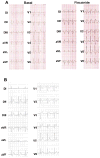Gain-of-function mutation S422L in the KCNJ8-encoded cardiac K(ATP) channel Kir6.1 as a pathogenic substrate for J-wave syndromes
- PMID: 20558321
- PMCID: PMC3049900
- DOI: 10.1016/j.hrthm.2010.06.016
Gain-of-function mutation S422L in the KCNJ8-encoded cardiac K(ATP) channel Kir6.1 as a pathogenic substrate for J-wave syndromes
Abstract
Background: J-wave syndromes have emerged conceptually to encompass the pleiotropic expression of J-point abnormalities including Brugada syndrome (BrS) and early repolarization syndrome (ERS). KCNJ8, which encodes the cardiac K(ATP) Kir6.1 channel, recently has been implicated in ERS following identification of the functionally uncharacterized missense mutation S422L.
Objective: The purpose of this study was to further explore KCNJ8 as a novel susceptibility gene for J-wave syndromes.
Methods: Using polymerase chain reaction, denaturing high-performance liquid chromatography, and direct DNA sequencing, comprehensive open reading frame/splice site mutational analysis of KCNJ8 was performed in 101 unrelated patients with J-wave syndromes, including 87 with BrS and 14 with ERS. Six hundred healthy individuals were examined to assess the allelic frequency for all variants detected. KCNJ8 mutation(s) was engineered by site-directed mutagenesis and coexpressed heterologously with SUR2A in COS-1 cells. Ion currents were recorded using whole-cell configuration of the patch-clamp technique.
Results: One BrS case and one ERS case hosted the identical missense mutation S422L, which was reported previously. KCNJ8-S422L involves a highly conserved residue and was absent in 1,200 reference alleles. Both cases were negative for mutations in all known BrS and ERS susceptibility genes. K(ATP) current of the Kir6.1-S422L mutation was increased significantly over the voltage range from 0 to 40 mV compared to Kir6.1-WT channels (n = 16-21; P <.05).
Conclusion: These findings further implicate KCNJ8 as a novel J-wave syndrome susceptibility gene and a marked gain of function in the cardiac K(ATP) Kir6.1 channel secondary to KCNJ8-S422L as a novel pathogenic mechanism for the phenotypic expression of both BrS and ERS.
Copyright © 2010 Heart Rhythm Society. Published by Elsevier Inc. All rights reserved.
Figures




Comment in
-
A gain-of-function I(K-ATP) mutation and its role in sudden cardiac death associated with J-wave syndromes.Heart Rhythm. 2010 Oct;7(10):1472-4. doi: 10.1016/j.hrthm.2010.07.027. Epub 2010 Aug 22. Heart Rhythm. 2010. PMID: 20736095 Free PMC article. No abstract available.
Similar articles
-
Molecular genetic and functional association of Brugada and early repolarization syndromes with S422L missense mutation in KCNJ8.Heart Rhythm. 2012 Apr;9(4):548-55. doi: 10.1016/j.hrthm.2011.10.035. Epub 2011 Nov 3. Heart Rhythm. 2012. PMID: 22056721 Free PMC article.
-
Electrophysiological analyses of transgenic mice overexpressing KCNJ8 with S422L mutation in cardiomyocytes.J Pharmacol Sci. 2017 Sep;135(1):37-43. doi: 10.1016/j.jphs.2017.08.009. Epub 2017 Sep 6. J Pharmacol Sci. 2017. PMID: 28928055
-
Loss-of-function mutations in the KCNJ8-encoded Kir6.1 K(ATP) channel and sudden infant death syndrome.Circ Cardiovasc Genet. 2011 Oct;4(5):510-5. doi: 10.1161/CIRCGENETICS.111.960195. Epub 2011 Aug 11. Circ Cardiovasc Genet. 2011. PMID: 21836131 Free PMC article.
-
Role of ATP-sensitive K+ channels in cardiac arrhythmias.J Cardiovasc Pharmacol Ther. 2014 May;19(3):237-43. doi: 10.1177/1074248413515078. Epub 2013 Dec 23. J Cardiovasc Pharmacol Ther. 2014. PMID: 24367007 Review.
-
J wave syndromes: molecular and cellular mechanisms.J Electrocardiol. 2013 Nov-Dec;46(6):510-8. doi: 10.1016/j.jelectrocard.2013.08.006. Epub 2013 Sep 6. J Electrocardiol. 2013. PMID: 24011992 Free PMC article. Review.
Cited by
-
Gene mutations in cardiac arrhythmias: a review of recent evidence in ion channelopathies.Appl Clin Genet. 2013 Jan 18;6:1-13. doi: 10.2147/TACG.S29676. Print 2013. Appl Clin Genet. 2013. PMID: 23837003 Free PMC article.
-
KATP channels and cardiovascular disease: suddenly a syndrome.Circ Res. 2013 Mar 29;112(7):1059-72. doi: 10.1161/CIRCRESAHA.112.300514. Circ Res. 2013. PMID: 23538276 Free PMC article. Review.
-
Novel Therapeutic Strategies for the Management of Ventricular Arrhythmias Associated with the Brugada Syndrome.Expert Opin Orphan Drugs. 2015;3(6):633-651. doi: 10.1517/21678707.2015.1037280. Epub 2015 May 13. Expert Opin Orphan Drugs. 2015. PMID: 27559494 Free PMC article.
-
The Potential Role of Creatine in Vascular Health.Nutrients. 2021 Mar 5;13(3):857. doi: 10.3390/nu13030857. Nutrients. 2021. PMID: 33807747 Free PMC article. Review.
-
Brugada Syndrome and Early Repolarisation: Distinct Clinical Entities or Different Phenotypes of the Same Genetic Disease?Arrhythm Electrophysiol Rev. 2016 Aug;5(2):84-9. doi: 10.15420/AER.2016.23.2. Arrhythm Electrophysiol Rev. 2016. PMID: 27617086 Free PMC article.
References
-
- Rosso R, Kogan E, Belhassen B, et al. J-point elevation in survivors of primary ventricular fibrillation and matched control subjects: incidence and clinical significance. J Am Coll Cardiol. 2008;52:1231–8. - PubMed
-
- Chen Q, Kirsch GE, Zhang D, et al. Genetic basis and molecular mechanism for idiopathic ventricular fibrillation. Nature. 1998;392:293–6. - PubMed
Publication types
MeSH terms
Substances
Grants and funding
LinkOut - more resources
Full Text Sources
Medical
Molecular Biology Databases

